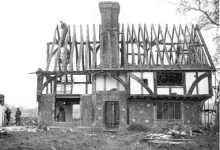Wealden hall house
The Wealden hall house is a type of vernacular medieval timber-framed hall house traditional in the south east of England. Typically built for a yeoman, it is most common in Kent (hence "Wealden" for the once densely forested Weald) and the east of Sussex but has also been built elsewhere.[1] Kent has one of the highest concentrations of such surviving medieval timber framed buildings in Europe.[2]

.JPG.webp)

The original floor plan usually had four bays with the two central ones forming the main hall open to the roof with the hearth in the middle and two doors to the outside at one end forming a cross passage.[3] The open hearth was later moved towards the cross passage and became a fireplace with chimney, sometimes the chimney pile even blocking the cross passage, which had soon been screened off the main hall. Beyond the cross passage the outer bay at the "screens end" or "lower end" of the hall, usually contained two rooms commonly called buttery and pantry, while the rooms in the bay at the other end, the "upper end", were called parlours. The end bays each had an upper floor containing solars, which did not communicate with each other, as the hall rose to the rafters between them. The upper stories on both ends typically extended beyond the lower outer wall being jettied on at least one side of the building. As the main hall had no upper floor the outer wall ran straight up without jettying, and thus the central bays appeared recessed. The early buildings had thatched roofs and walls of wattle and daub often whitewashed. Later buildings would have a brick infilling between timbers, sometimes leading to a complete replacement of the outer walls of the basement with solid stone walls.
Examples
Examples are the "Bayleaf farmhouse" from Chiddingstone, relocated in 1968–69 to the Weald and Downland Open Air Museum.[4] the Yeoman's House in Bignor, the Anne of Cleves House in Lewes, the Alfriston Clergy House, the Plough at Stalisfield Green, the Old Punch Bowl[5] and the Ancient Priors[6] at Crawley, the Pattyndenne Manor in Kent and the Monks' Barn in Newport, Essex, Hole Cottage near Cowden (operated by Landmark Trust) and The Old Bakery, in Hamstreet, Kent.[7] The northernmost examples are in York, and include the Wealden Hall on Goodramgate.[8]
References
- Platt, Colin (1995). Medieval England: A Social History and Archaeology from the Conquest to 1600 AD. Routledge. p. 203. ISBN 978-0-415-11915-3. at Google books
- Quiney, Anthony (1989). Period Houses, a guide to authentic architectural features. London: George Phillip. ISBN 0-540-01173-8.
- Brunskill, R. W. (2000). "Rural houses and cottages; Wealden and other open-hall houses". Houses and Cottages of Britain: Origins and Development of Traditional Buildings. Yale: Yale University Press. p. 54. ISBN 978-0-575-07122-3. (Plans may be viewed online at google books here.)
- Description of the Bayleaf farmhouse at the Weald and Downland Open Air Museum,
- Historic England (2007). "No 101 (National Westminster Bank) (formerly listed as The Punch Bowl), High Street (east side), Crawley, West Sussex (1187086)". National Heritage List for England. Retrieved 2009-10-15.
- Historic England (2007). "No 49 and No 51 The Ancient Priors (Minters Restaurant a Louis Coiffeur) (formerly listed as No 47, The Square), High Street (east side), Crawley, West Sussex (1207420)". National Heritage List for England. Retrieved 2009-10-15.
- Historic England. "THE OLD BAKERY (1071197)". National Heritage List for England. Retrieved 2017-01-16.
- "Wealden Hall, 49 & 51 Goodramgate". York Conservation Trust. Retrieved 27 August 2020.
